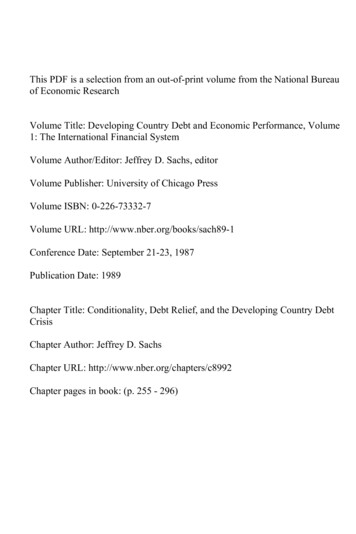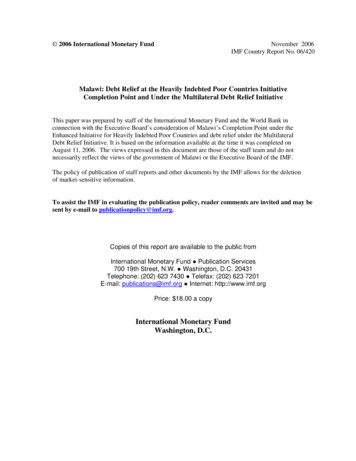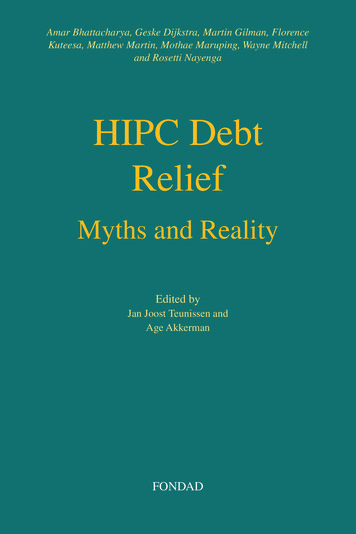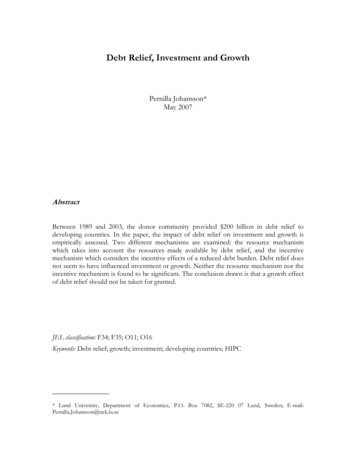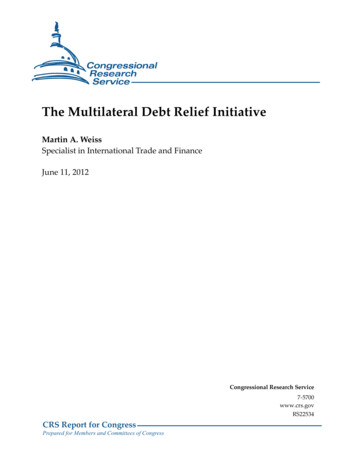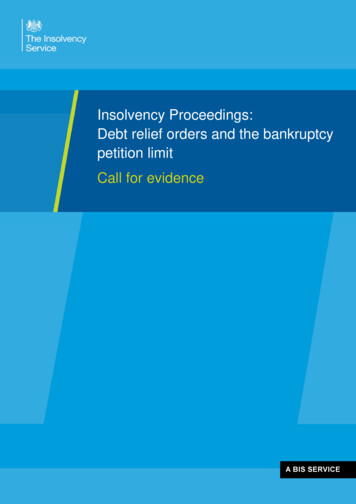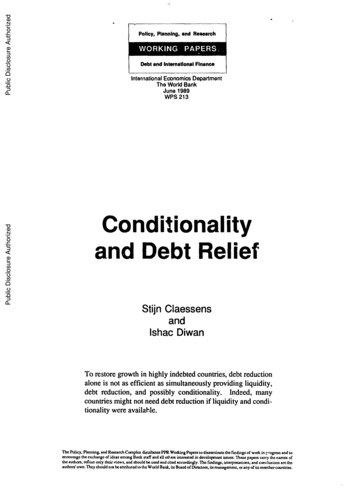
Transcription
WORKINGPAPERS.Debt and International FinanceInternational Economics DepartmentThe World BankJune 1989WPS 213Public Disclosure AuthorizedPublic Disclosure AuthorizedPublic Disclosure AuthorizedPublic Disclosure AuthorizedPolicy,Planning,and ResearchConditionalityand Debt ReliefStijn ClaessensandIshacDiwanTo restore growth in highly indebted countries, debt reductionalone is not as efficient as simultaneously providing liquidity,debt reduction, and possibly conditionality. Indeed, manycountries might not need debt reduction if liquidity and conditionality were available.The Policy, Planning, and Research Complex distributes PPR WorkingPapers to disseminate the findings of work in progress and toencourage the exchange of ideas among Bankstaff andal oth-ersinterested in development issues. These papers carry the names ofthe authors,reflect only their views, and should be used and citedaccordingly. The findings, interpretations, and conclusions are theauthors own.They should not be attributedto the World Bank. its Board of Dimctors,its management, or any of its member countries.
Plc,Planning,and ResearchDebtand InternationalFinanceSix years into the debt crisis, questions about therelevance of policy measures to alleviate thecrisis still abound. Conditionality by intemational financial institutions and rescheduling bycommercial creditors have been dismissed infavor of debt reduction as strategies for restoringthe creditworthiness of heavily indebted countries,Claessens and Diwan argue that the combination of conditionality and new private money- if properly interpreted and correctly implemented - should not be dismissed too lightly.They contend that liquidity (the availability ofcurrent resources) in the debtor country isprobably as important an incentive for a countryto invest and adjust as having a small enoughdebt stock outstanding.Debt reductijn alone, they argue, is not asefficient as simultaneously providing liquidityand debt reduction. Indeed, many countriesmight not riced debt reduction if liquidity wereavailable.Conditionality produces efficiency gains byreducing creditor concerns thb1 !'e debtorcountries will "cheat" on their promises to adjustand invest. This reduced concern inducescreditors to provide new loans and reduce thedebtor's liquidity constraints. Increased investment produces efficiency gains that can then bedistributed between debtors and creditors,reducing the need for debt relief.The combination of new money and conditionality will work if the debt siock is smallenough and enough new money is available.This paper, prepared for the conference "Dealing with the Debt Crisis," is aproducLof the Debt and International Finance Division, International EconomicsDepartment. Copies are available free from the World Bank, 1818 H Street NW,Washington DC 20433. Please contact Sheilah King-Watson, room S7-033,extension 33730 (46 pages with charts).The PPR Working Paper Series disseminates the findings of work under way in the Bank's Policy, Planning, and RcscarchComplex. An objcctive of the series is to get these findings out quickly, even if presentations arc less than fully polished.The findings, interpretations, and conclusions in these papers do not necessarily represent official policy of thc Bank.Produced at thc PPR Dissemination CenterJ
Table of Contentr1.Introduction32.Equilibria Without A Precommitment MechanismA Simple ModelInefficient InvestmentA. Liquidity ConsiderationsB. The Tax Effect of A Large DebtPareto Efficient Allocations Without PrecommitmentsA. The Debtor's Optimal Take-It-Or-Leave-It OfferB. The Creditors' Optimal Take-It-Or-Leave-It OfferThe Set of Efficient Allocations without Precommitments8810101214141719The Effect Of The Precommitment TechnologyThe Debtor's Optimal OfferThe Creditors' Optimal OfferThe Multiplicity of Efficient AllocationsWeak and Strong Debt Overhang20212325254.Implications for Conditionality and Multi]ateral ts by the discussant, Guillermo Calvo36Figure462.12.22.32.43.3.13.23.33.4This paper was presented at the World Bank Conference on "Dealing withthe Debt Crisis", January 26-27, 1989, Washington, D.C. We would like to thankour discussant, Guillermo Calvo for very useful comments.
-3-CONDITIONALITY AND DEBT RELIEF1. IntroductionSix years into the debt crisis, questionsabout the relevanceofpolicy measures to alleviate the crisis still abound. The presentstate of affairs is often describedas inefficientin the sense thatpotential efficiencygeins which can lead to benefits for all partiesinvolvedexist but policies to achieve these gains are not beingimplemented.In particular,economicprojectswith a rate of returnlarger than the world interestrate are not undertaken in debtorcountries.The present situationcan in effect be,viewed as theinefficientoutcome of a prisoner'sdilemma game: certain coordinatedacts of creditors and debtors can thereforeimprove both theirwelfare.In general, inefficienciesin this context are due to one (or acombination)of the three followingfactors: (i) coordinationfailureswithin each party coalition;(ii) the negotiatingand bargainingprocess between the parties;and (iii) the lack of crediblemechanismsproblems. The firstthat could be used to alleviate time-inconsistencyfactor is fairly well understood:on the creditors side, the mainproblem derives from the difficultyof privately financinga publicgood (the so called "free-riderproblem):on the debtor side, thedifficultyfor the governmentconsists of undertakingefficientmeasures that may hurt some constituencyand benefit others (eitherbecause of lacking redistributiveinstrumentsor strong pressures fromWe will not discuss this first factorindividualccnstituencies).1iere.
-4-The second factor refers to the perverse incentiveeffect of alarge debt outstandingon the willingnessof the country to adjust andinvest and on the willingnessof the creditors to provide newfinancing.Without an injectionof liquidity,additionalinvestmentiscostly to the debtor as current consumptionwill have to be reduced,an unattractivealternativeafter six years of austerity that haslowered (for some countries)per capita consumption(and income) tolevels below those of the early eighties.' Moreover, given the natureof the bargainingand negotiatingprocess, the future benefits ofausterity and investmentwill be shared between the debtor and thecreditors,with a larger share of the benefits going to the creditorsthe more indebted the country is. This reduces the incentivesfor thedecisions in a way that iscountry to adjust its investment/savingmore compatiblewith their foreign obligations.At issue is thus theway in which the current costs and the future benefits of additionalinvestmentwill be divided between the debtor and creditors,in theform of provision of current liquidityand future debt repayment,andwhether more efficientsharing mechanismscan be designed in order toexploit existinggrowth opportunitiesand achieve a higher growthequilibrium.If however, creditors are not willing to share in the costs ofnew domestic investmentsby extendingnew loans (or providing anyother form of liquidityrelief) and/or are rnotwilling (or able) toprecommit themselvesto reduce their share of the future returns on1 In this context, investmentshould be interpretedbroadly to includestructuraleconomicreforms of the debtor'scountry productiveresourcesand all other policies that requiresan expense of currentresources in return for higher consumptionin the future. Investmentcould thus includepolicies of cial sector reforms,public enterprisesrestructuring,as well as fiscal reforms.
-5the investment(i.e., write off some of their claims), the (net)marginal return on additionalinvestmentwill likely be too low forthe debtor to justify the requiredcurrent expense. Debtors would thenbe unwilling to undertakehigh investmentlevels. At the same time,its creditorswill not be willing to extend new loans or to reducetheir share of future output unless the debtor is able and willing toprecommit itself to increaseinvestment,as the moral hazard risk ofthe new resources largely going to current consumption,instead of toinvestment,will be too large. Inefficientbehavior from both thecreditors and the debtor can then rationallyco-exist as the outcomeof this prisoner'sdilema. The result is a low growth but timeconsistentequilibrium.Creditorswill try to grab as much as possibleof current resourcesand the debtor will underinvest in an effort toreduce future repayments.Both would be better off with more efficientcontracts:smaller current net transfersand higher investmentlevels,and a different sharing of output in the future.This paper will discuss the nature of the efficiencygains thatcan be obtainedand analyze the limits that moral hazard and timeconsistencyproblems impose on the feasibleefficient allocations.Themain focus of the paper will be to look at the additionalefficiencygains due to the existenceof a precommitmenttechnology.The paperwill analyze how efficienthigh growth equilibriacan be achievedthrough the use of a precommitmenttechnologyfor investments.Allowing for investmentprecommitmentsresults in equilibriawhichPareto dominatetime consistentequilibria.The efficiencygains arisefrom the possibilityof attractingmore capital to invest inproductiveprojects, leading to gains which can be distributedsuchthat both parties at least as well off as in the stattwquo, lowgrowth equilibrium.
-6The analysis yields importantpolicy implications,withparticular important interpretatLonsfor the concepts ofconditionalityand debt relief. The paper shows that debtors thathave lost their credit-worthinessfall in two broad categories:thosethat experiencea weak debt overhangand those that are in a strongdebt overhang. In cases of weak debt overhang,new loans andprecommitmentson investmentcan be sufficientto restore creditworthinessand achieve a high growth equilibrium.However, in cases ofstrong debt overhang debt relief is also needed. In this latter case,the third party, e.g., multilateralinstitutions,should refuse toprovide the precommitmenttechnologyunless a portion of theoutstandingdebt is written off. Otherwise,new (conditional)loanscannot lead to a restorationof credit-worthiness.The importantproblem the precommitmenttechnologyraises for the third party (e.g.,the multilateral)is how the efficiencygains will be distributedbetween the creditorsand the debtor. Besides strategicconcerns, theexistence of externalitiescan influencethe choice of themultilateral.The paper is structuredas follows:in section 2, we set up asimple model that captures the interactionsbetween the debtor cointryand creditorswithout precommitments,and we study the optimal actionsbetween creditors and the debtor country. In section 3, we study theoptimal actions of the debtor country and the creditorsunder theassumptionof an effectiveprecommitmenttechnologyprovided by athird party. §Wti-4 provides an interpretationof the precommitmenttechnologyin terms of multilaterallending and draws implicationsforthe way in which multilateralsoperate.This section also discussesthe importanceof externalitiesinvolvedin situationsof a debtoverhang and their effect on the way the multilateraluses itsprecommitmenttechnologyfor the benefit of the debtor or creditors.
-7.Section 5 concludes by outlining importantextensionsand furtherrtresearch topics.
-82. EguilibriaWithout A Pecommitment MechanismWe start our analysisby ignoringprecommitmentpossibilities.The investmentdecision is then determinedby the debtor after nei0loans have been disbursed,i.e., in an ex-post optimal fashion. Thefocus is on the (standard)inefficienciesof a large external debtwhich debtor and creditorswill try to overcomeby making offers toeach other and, potentially,bargainingover these offers. The lack ofprecommicmentmechanism restricts the resultingallocationsto be atbest Pareto efficient in a constrainedsense. How further improvementscan be secured using a precommitmenttechnolugyis discussed insection 3.2.1 A SiMple ModelIn order to highlight the effect of debt policy on the efficiencyof the intertemporalallocationin the debtor country,the analysis iscast in terms of a simple two pe.iod, certaintymodel. We consider asmall, one good, open economy close in spirit to the economies ofKrugman (1987), Froot (1988),Corden (1988) and Sachs (1988). Thecountry is each period endowed with an exogenous supply of a good,which can be used for consumption,repayment of loans or investment.The country is a pricetaker in the internationalgoods and creditsmarkets and has an inheritedstock of foreigr.debt with an impliedobligationof D.,The country is governedby a central planner, who maximizes awelfare function subject to resourceconstraints.Decisionsmust bemade regardingnew externalborrowing and the allocationof currentresourcesbetween domestic investment,consumptionand external debtrepayment.The timing of the decisionsis as iollows: in the firstperiod the planner may borrow abroad subject to supply constraints;
-9the available resourcesare then divided by the debtor country betweeninvestmentand consumption;in the second period, the country makestransfers to the creditors from its endowment and the return on its2It isfirst period investment,and consumes the remainingresources.assumed that the creditorshave a "gunboat"technologyfor capturingall of the country'ssecond period resources in case output fallsshort of the amount of debt service due and the country defaults.3The economy can be representedby the following five equations:W-U(Cd) bC 2(2) C1-E L-I(3) C2-E f(I)-R(4) R-min[E f(i),D](5) P-R-L(1)where E is the country's endowmentof the good in each period; C.refers to aggregateconsumptionin period i-1,2; I denotes theinvestmentlevel; f(I) the return on investmentin the second periodwith f' O and f'' O; L is the amouantof resources (liquidity)lent inperiod one; and D is the requiredrepayment in t-2 (which includes therepayment on loan L). The actual repaymentnext period is given by R.The debtor'swelfare is given by equation (1): U(C1 ) is a first periodutility functionwhich satisfies the usual concavity and Inadaconditionsand b is the country'sdiscount factor. For analyticalconvenience,second period utility is chosen to be linear.4 We assumeThe results of the model would not change if it was assumed that thecountry also transfersan amount of resourcesto the creditors in thefirst period, as long as that amount is independentof its investmentdecision.3 Assuming that the creditorscan only obtain part of the country'sresources in event of a default does not change the major conclusionsof the analysis,but drasticallycomplicatesthe algebra.' This avoids having to deal with risksharingconsiderations.The2
-10-that the world interestrate is zero for analyticalconvenience.Toreflect the relativescarcityof capital in the debtor'scountry, thecountry's discountfactor is assumed to be below the world's discountrate, i.e., b l. The creditorsnet payoff, equation (5), is thedifferencebetween the amount actually repaid next period and theamount of resources lent this period: the amount of debt outstanding,Do is considereda sunk cost.2.2 AnefficientInvestmentThere is room for Pareto-improvementif, due to the large deb,overhang, the country is not undertakinginvestmentopportunitieswhich, evaluatedat the world's interestrate, are profitable in5themselves.Th model incorporatestwo broad factors that generateincentivesto underinvest.LCe scarcityof liquidityand the attemptto evade future debt repayments.6A. LiquidityConsiderationsThe opportunitycost of current investment-in terms of forgonecurrent consumption-increaseswith the scarcityof current resources.As a result, the country'seffectiverate of time preferencebecomeslarger than the world interestrate, rendering investmentopportunitiesthat are valuableby internationalstandardsgualitativeoutcomesof the model e i not affected,however.In other words, there is underin fi tment when f'(I) l.6 Other effects of a debt overhangwill not be analyzedhere. Forexample, the temptationto chose riskier projects in a go-for-brokestrategyhas been well described in the corporatefinance literature.In a go-for-brokestrategythe country can make investmentsworthwhileif they are risky enough and pay off sufficientlyin good states ofnature to pay back the creditorsand yield some return to the debtor.The outcome in bad states of nature is of less interestto the debtoras all or part of the rewards will go to the creditors anyway.
-117 New foreign lenderswill not financeunattractive.these profitableinvestmentopportunitieswhen the line of e:cistingexternalcreditorsis already too long. But, existing foreign creditorsmight want tofinance new investmentsin order to increasethe size of the economicpie to be divided rnextperiod between them and the country as long asthey are assure, that (part of) their new loans will be used forinvestment.However, the country decides after having received the newloans how to divide its resourcesbetween optimallybetween investmentand consumption.The ex-post tradeoffof the country will lead thecountry to invest less than the amount of the loan provided. Thecreditorswill take he debtor'sex-post tradeoffinto account inmaking their ex-ante decisio-iregardingnew loans. This timeconsistency,or ex-ante ver'.usex-post,problem is exacerbatedif thedebtor is liquidityconstrainedand, after receivingnew loans, isunwilling to sacrifice consumptionto undertake all profitableinvestmentprojects.To illustratethis relationshipbetween investmentand liquidity,we solve for the country's investmentproblem given an amount ofliquidityLand assume for the moment that the large contractualdebtrepaymentnext period does not constitutea disincentiveto invest.The maximizationof welfare, (1), subject to (2) and (3), implies thatI* is an implicitfunctionof liquidity,L, which satisfies:(6)f'(I*)-U'(E L-I*)/b.The liquidityconstraintis a reflectionof the relative scarcityofresources in the debtor country. It is speciallymeaningfulin highlyindebtedcountrieswhere real income has declinedmarkedly in therecent past. In this regard, it is worth pointing to the fact thatcapital accumulatedabroad by the private sector (capitalflight) doesnot provide the public sector with resources it can tap. Thus, publicinvestmentcould well be constrainedby liquidityconsiderationsevenwhen a segment of the private sector has accumulatedreserves abroad.7
-12When the debtor is liquidityconstrained,he will be unable toreduce U' to the level of his discount factor b and equate hisintertemporalmarginal rate of subrtitutionfor consumptionto theworld interestrate, 1. The marginal return on investment,f', willexceed 1 in this situation and valuable investmentopportunitieswillthereforebe foregone.An increasein liquidityL would, of course,release the liquidityconstraintand would increaseI* as part of the8new resourceswould be invested.B. The Tax Effect Of A Large DebtWhen the amount of forpign debt outstandingDo is large enough,the associatedfuture repaymentobligationcan act as a disincentiveon investmentas a share of the gross return on investmentcan go tothe creditorsand not ttuthe country.This has been called the taxeffect of a large debt.9 The "gunboat"technologyin the modelhighlightsthis effect. When the future debt obligationD is largeenough, the debtor can expect that all of its future resourceswill beseized by its creditors.It then becomes rationalfor the country toconsume all current resourcesar.4to invest none. This occurs when(using equation (6) and assumingrationalexpectations)D is largeenough to make welfare with investmentI*(L) and debt repayment D,i.e., W - U(E-I*(L) L) b(E f(I*(L))-(D)),lower than welfare under noinvestmentand default, i.e., utility level U(E L).a It is easy to show that 0 dI*/dL UID/(U' bf'') 1.(1988) has first analyzed the effects of a debt overhang thisway. The tax effect can operate either on the incentivesof a centralplanner governinga country or, in the context of a market economywith a large public debt, on the investmentincentivesof the privatesector. In the later case, the investmentdisincentivesarise from theexpectationof the increasedfuture taxationthat is necessary tooperate a transferfrom the private sector to the public sector.9Sachs
-13-Summarizing,the debtor country will choose to invest I*(L) andrepay D when the debt outstandingsatisfies:(7)D 59E f(I*(L))-[U(E L)/b] [U(E-I*(L) L)/b]-V8x(L,I*(Q))As I* is a functionof L one can write DP(L,I*(L)) as an(implicit)function of L alone, i.e., D'"(L). In effect, De(L) isthe maximum amount that creditorswill be able to receive from thecountry if they provide new loans in the amount L. If creditors askedfor more, the debtor would prefer not to invest and to repay nextperiod only E. This would imply that creditorswould end up gettingless than Dm.However,when the creditorsasks for less than Dm,oroutstandingdebt is below D¶a, the debtor will invest I* in an expost optimal fashion and repay its full amount. If the inheriteddebtexceeds Dm" a write off of the old debt to the maximum level, Dm(L)will increasethe debt repayment and the economicpie.It is easy to check that Dig is an increasingfunction of L. Asthe availabilityof larger current resources increases,thisencouragesinvestmentwhich then increasesthe amount that can beextracted from the debtor.The importantimplicationof the dual liquidityand tax effect oninvestmentis that, in general, the incentivefor investmentwilldepend on the amount of liquidityas well as on the amount of debt tobe repaid next period. For efficiencygains, the optimal provision ofincentivesto repay will thereforehave to be a mixture of liquidity0 We will concentraterelief and debt write-offs.'in the remainderof10 See Froot (1988) for an elaboration.
-14-the paper on the case where inheriteddebt Do is larger than themaximum amount creditorscan expect to receive without an amount ofnew liquidity,Dm"(O).1l In this circumstance,the debtor will notinvest unless (part of) his obligationis written-offand/or he isgranted some liquidity relief.2.3 Pareto EfficientAllocationsWithout PrecommitmentsThe status-quoof no write-offsand no fresh liquidityproduces autility level of W0-U(E) for the country and a payoff of P.-E for thecreditors.The debtor and its creditorscan now exchangeoffers about(L,D), the amount of period one liquidityand the level of future12repayment,to improveupon the status-quo.Of course, we restrictall offers (D,L) to be time consistent.This implies that if an amountof liquidityL is advanced in period one, an amount I*(L) is expectedto be, and will be, investedby the country. Subsequently,an amountD*, consistentwith the "gunboat"technologyof the creditors and thedebtor's tradeoffs,will be paid back in period two. This imposes twoconstraints:(i) the debtor is best off investingafter receiving theloan, i.e., equation (7) holds; and (ii) the debtor cannot be betteroff after investingnot repayingD and having its output seized, i.e,[E f(I)]"D.As it turns out, the latter constraintis always satisfiedwhen constraint (7) holds, so only constraint (7) is necessary.A. The Debtor's Optimal Take-It-Or-Leave-ItOffer11With rationalexpectations,competitivelenderswill actually lendvoluntarilyuntil the debtor obligationreaches the credit ceilingDmax. Under uncertainty,large negativeshocks that raised the burdenof the debt relative to the credit ceiling (interestrate and exchangerate shocks, productivityand terms of trade shocks) could causeoutstandingforeign debt to exceed Dmax.12 When a commitmenttechnologyis used, the offers will alsocondition investmentand take the form of a triplet (I,L,D).Seefurther section 3.
-15-To improve its welfare level beyond the status-quoutility level,WOO the debtor would want the creditorsto lend more today (in orderto reduce the liquidityconstraint)and to commit themselvesto reducetheir share of future output (in order to eliminate the tax effect).In return, the debtor would be willing to invest more and repay alarger amount next period. Its preferredunilateraloffer of liquidityand repayment levels (D*,L*)must satisfy the time consistencyconstraint (7) and it must leave the creditorsno worse off than underthe status-quosituation.In other words, it must, apart from (7),also satisfy:(8) P-D-L Po-E.The optimizationproblem for the debtor becomes then:Max W-U(E-I*(L) L) b[E f(I*(L))-D]D,Lsubject to equations (7) and (8).The problem is illustratedin figure 1 in (D,L) space. Thewelfare functionof the country results in indifferencecurves whichslope north-east.The creditors'indifferencecurves consist of 45degree lines, such as lines (8), with the intersectionof the lineswith the vertical axis representingthe net payoff P. The maximizationof the debtors'swelfare will imply the minimizationof the creditors'net return P and thereforethe constraintin equation (8) will alwaysbe binding. The debtor will thus choose its preferredpoint on theline marked (8) and will furtherbe constrainedby equation (7),representedby line (7). Assuming that the debtor has a relativepreference for liquidity,it will then prefer increasesin L over
-16reductionsin D, and would want to move north-eastalong line (8). Inthat case, the maximal liquiditywill be obtainedat point B, a cornersolutionwhere the time consistencyequation (7) will also be binding.Point A could lead to a higher utility because of the greaterliquiditybut is not feasiblebecause it violates the time consistencyconstraint (7). If the preferencefor liquidity is however not asgreat as assumed, an optimal offer could be for example C.If the offer (D*,L*) is acceptedby the creditors,the resultingallocationwould differ from the status-quoallocation(E,O) in thefollowingways: the creditorswould provide liquidityrelief to theamount of L* and would write-off the outstandingdebt from DO to D*.Their total payoff would be unchanged,as more would be collected inthe future to offset the new loan L*, i.e., D*-E L*.The debtoraccepts to adjust by investingmore, and by possibly imposingausterity,today in return for debt relief tomorrow,and is better offgiven his relativepreferencesfor liquidity.However, the time consistencyconstraint(7) will still limit theallocationsand will not allow a fully realized investmentpotential." The liquidityconstraintwill bind and the debtor willwant to increaseL if he could. In order to leave the creditorsaswell off, this would imply an increasein the promised repaymentD,which, however, will not be credibleas the debtor will be better off,after receiving the loan, not investingat all. Although additionalfunds could be very productiveif invested,they will not beforthcomingbecause, once new loans have been disbursed,the countryIn other words, U'(E L*-I*) band therefore (using 6) f'(I*) l.Ifthe debtor is currentlynot too liquidityconstrained,equation (7)will not be binding and U'-b, f'(I*)-l (such as point C on figure 1).But for offers that give the creditorssome larger payoff P equation(7) will be binding and not all profitableinvestmentopportunitieswill be realized.13
-17has little incentivesto invest given the amount of outstandingdebtobligations.Additional loans could be secured and larger efficiencyimprovementscould be unlocked if the debtor could crediblybear alarger debt burden, by, for example,committingto a certain level ofinvestment.B. The Creditors'Optimal Take-It-Or-Leave-ItOffersThe creditors,acting as a coalition,can constructa unilateraloiter in terms of (L,D), i.e., an amount of liquidity,L, and arequiredrepaymentnext period of D, which can increasetheir netreturn, P-D-L, and leave the debtor at an as low as possiblewelfarelevel. The provisionof liquidityL can increasethe creditors'netpayoff as the debtor will invest a fractionof the new resources,which can lead to a sufficientincrease in next period's output, part14of which output will be available for debt service.In choosing their optimal offer, (L*,D*),the creditorsmustanticipatethe investmentreactionof the debtor. As before, this isgiven by the implicit functionI*(L) that satisfiesequation (6). Theoffer includesa reductionof the debt obligationin order to inducethe debtor to invest I* (i.e., constraint(7) holds). Since the bestoffer actually leaves the debtor indifferentbetween investing and notinvesting,(7) will be binding and will hold as an equality, i.e.,D*-Dm x(L*), resulting in an (implicit)functionfor D* in terms ofL*. In terms of figure 1, the creditorswill choose their preferredoffer along the line correspondingto function (7), with theirindifferencecurves being 45 degree lines and an increasein payoffsThis part of the model is identicalto the case discussedby Froot(1988).14
-18representedby a movement ixorth-west.Taken into account that constraint(7) is binding, the optimalchoice (D*,L*)maximizes P-D(L)-Lwith respect to L. The optimalamount of first period loans solves the first order condition:- f'(I*)-[U'(E L*)/b]-l(9) 0 - [U'(E L*-I*)/b]-[U'(E L*)/b]-lin which equation (6) is used. This equation solves, in an implicitmanner, for L*. In turn, equation (6) solves for I* and equality (7)for D*. The solution is representedas point F on figure 1. Thecreditors'offer will imply a lower repaymentin period two comparedto what the debtor would have offered in his own unilateraloffer anda lower offer in period one of liquidity,but a higher net return(Y E).InvestmentI* will be above the status-quoinvestment,I 0, whichgives rise to the Pareto improvement.The creditors'payoff isincreasedfrom Po-E to P*-D*-L*-Yand the debtor'swelfare isincreasedfrom W0-U(E) to W* U(E L*). Interestingly,creditors needto share the efficiencygains from increasedinvestmentwith thedebtor in order not to induce the debtor to default after receivingthe new loan.From (9) we know that f'(I*) l, implyingthat not all profitableinves
debt stock outstanding. tionality will work if the debt siock is small enough and enough new money is available. This paper, prepared for the conference "Dealing with the Debt Crisis," is a producL of the Debt and International Finance Division, International Economics Department. Copies are available free from the World Bank, 1818 H Street NW,


